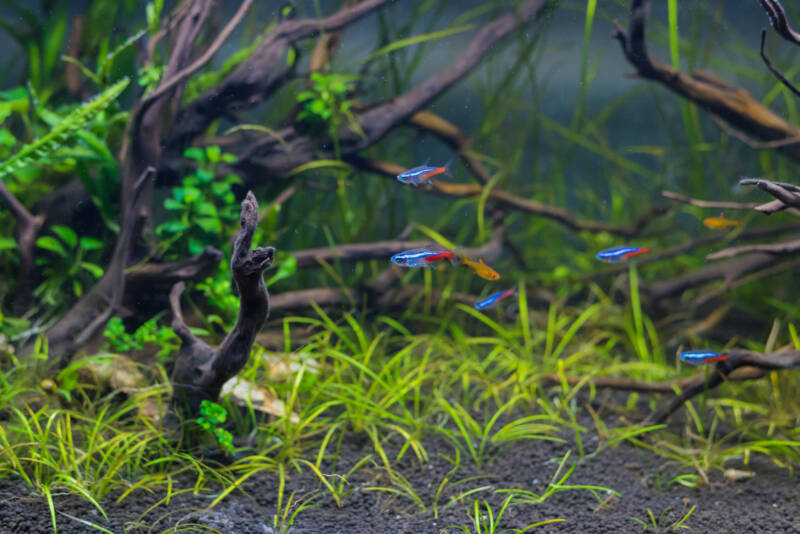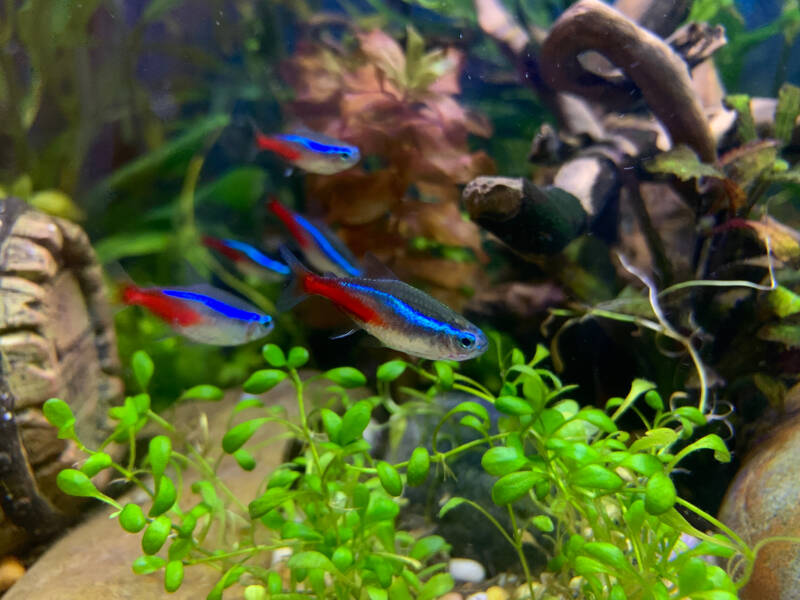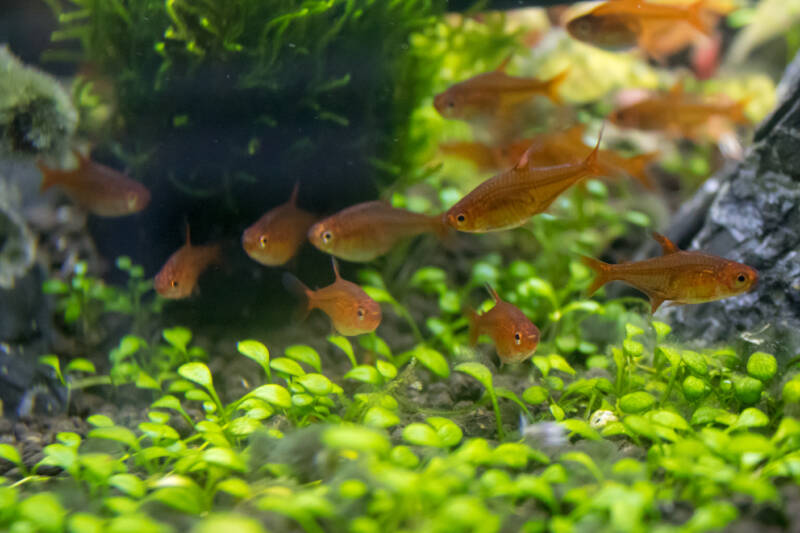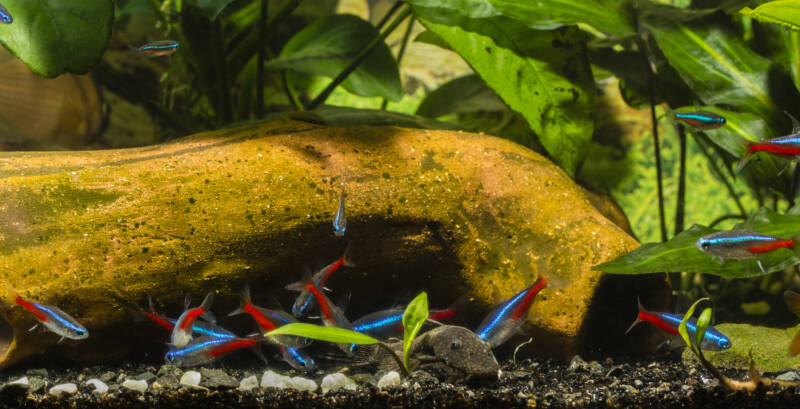If you are looking for a pair of ideal tank mates, look no further than the neon tetra and ember tetra.
These species, both from the Characidae family, are not only hardy fish that are perfect for beginners, but they are also perfectly compatible as tank mates in terms of habitat needs and behavior.

Plus, these schooling fish are beautifully colored and incredibly lovely to behold. They look amazing with a well-planted tank as a backdrop.
Read on for more information on these excellent roommates and how to set up the perfect tank.
[toc]
Species Profiles
Of all the types of tetras out there, neon and ember tetras are popular for good reason. They are attractive, hardy fish that will look stunning together in your tank.
Size and Appearance
Neon tetras

Neons (Paracheirodon innesi) steal the show with their vibrant silver, red, and blue coloration.
The blue line is especially stunning as its iridescent properties give it a glowing, reflective look.
Neon tetras kept in captivity grow to around 1.5 inches (3.8 cm) in length. In the wild, they can reach up to 2.5 inches (6.4 cm).
Neon tetras are often mistaken for cardinal tetras (Paracheirodon axelrodi). To tell the difference, check the length of the tetra’s red line. For cardinals, it will extend almost head to tail, while for neon tetras, it covers the back half of the fish.
Ember tetras

Ember tetras (Hyphessobrycon amandae) are diminutive, reaching an adult length between 0.6 and 0.8 inches (1.5 to 2 cm).
The size difference between the two species will not be an issue as each fish will generally keep to its own group.
Ember tetras look amazing in a school with their glowing orange/red color that resembles the warm embers of a fire.
Lifespan
For such tiny fish, neon tetras have an impressive lifespan of five to 10 years.
Ember tetras have a slightly shorter lifespan. You can expect them to live two to three years with excellent care.
Natural Habitats
Neon tetras are native to the Amazon River Basin and Orinoco River system. They can be found in Brazil, Colombia, and Peru.
Ember tetras come from central Brazil, where the Araguaia River Basin hosts a large population.
Both neon and ember tetras inhabit slower moving waterways and blackwater environments, where the lighting is low due to the abundance of plant life.
Behavior and Compatibility
Both neon tetras and ember tetras are peaceful fish, and each species will form a school in your tank.
Neon tetras favor the middle to top levels of the tank, while ember tetras can be found in all tank levels.
Both types of tetras need to be kept in a group to feel comfortable and exhibit their best behaviors. Solitary fish of either species will be stressed and prone to illness.
Keep both neon and ember tetras in groups of at least six to eight fish. An even larger group of ember tetras, around 10 to 15, may increase their comfort and activity levels.
Potential for Aggression
Of the two species, only the neon tetra has a chance of showing aggression. While these fish are not typically aggressive, they can display these behaviors if stressed.
Neon tetras are prone to fin nipping if they are kept in a tank that is too small or overstocked.
Keeping them in a group in a large and appropriately stocked tank helps to spread out any potential resource aggression and make them feel secure.
Be aware that the potential for aggression can also increase for the neon tetra during times of breeding. They may become nippy during these times, and you should transfer the breeding pair to a dedicated tank.
Tank Setup

It is important to establish and cycle your tank well before you add your fish.
Neon tetras are especially sensitive to shifts in water parameters. Never introduce them to an immature tank.
Below, we discuss things to consider when setting up your community tank.
Tank Size
To house a school of neon and ember tetras, you will need a minimum tank size of 20 gallons (80 l).
Anything smaller will increase stress levels for your fish and may also increase the chance for your neon tetras to show aggression.
Water Conditions
Both neon and ember tetras have compatible water condition needs, which is why pairing them is so simple. For reference, here are the recommended parameters for each species.
Neon tetras:
- Temperature: 70 to 81°F (21 to 27°C)
- pH: 6 to 7
- Hardness: 2 to 10 dGH
Ember tetras:
- Temperature: 68 to 82°F (20 to 27.7°C)
- pH: 5.5 to 7
- Hardness: 5 to 17 dGH
You can see where the parameters overlap. Keep the water conditions as close to the center of the overlapping areas as possible.
Water temperature should be on the warmer side, somewhere between 70 and 81°F (21 to 27°C). Make sure you have a reliable heater and thermometer to monitor the temperature and keep it steady within this range.
The pH range should be between 6 and 7 to meet the needs of both species. The water hardness can be anywhere from 5 to 10 dGH.
Water parameters should be kept as steady as possible. Rapid shifts in these measurements will increase stress for your neon tetras, making them more likely to be aggressive.
With their small size, ember tetras do not favor strong water movement in the tank. Install a suitable filter with an adjustable flow rate and clean your tank regularly.
A water change of 25 percent weekly will help keep your tank in excellent condition.
Plants and Decorations

Both neon tetras and ember tetras enjoy having plenty of plants and hiding places in their tank.
The addition of these not only replicates their lush natural environments but can also positively impact and maximize their health and lifespan.
Ember tetras especially benefit from the presence of live plants in their habitat and can suffer if they are kept in barren tanks.
In addition to recreating their natural habitat, there are other reasons why live plants are best – they provide multiple hiding spots.
If you select plants that grow to various heights in the water column, you can reduce stress for your fish by providing cover at any level. We love anubias, java fern, and Amazon sword for their hardiness and different growth heights.
Live plants are a natural part of a balanced nutrient cycle in a home aquarium, helping to regulate nitrate and oxygen levels.
They also diffuse the light entering the tank. Both species enjoy darker waters and can be stressed by overly bright lighting. Consider adding floating plants or driftwood to create shaded places.
Neon and ember tetras rarely visit the bottom of the tank, so feel free to line it with whatever substrate you choose. Substrates that accommodate your live plants are best.
Feeding

Feeding your fish adequately is key to maintaining peace in the tank. Aside from adequate tank space, food is another resource that can cause aggression between species.
Make sure you are feeding your tetras two to three times each day. Feed only as much as they can finish in a couple of minutes and remove any uneaten food to prevent it from impacting water quality.
These omnivores are easy to feed and commercial fish flakes can provide most of their nutrients.
With the ember tetra being smaller than the neon, make sure that the food you are feeding is small enough for your ember tetras to eat.
Supplement their diet by adding in treats, such as daphnia or baby brine shrimp.
Other Tank Mates
If you wish to add other species to your neon/ember community tank, there are several options.
Consider first those species that would occupy the lower and bottom levels of the tank.
As your neon tetras and ember tetras will stick to the middle and upper levels, a bottom-dwelling species will have less interaction with the schools and therefore lower the odds of any conflict.
Some of our favorite compatible bottom dwellers are:
- Cory catfish (Corydoras spp.)
- Otocinclus (genus)
- Ghost shrimp (Palaemonetes paludosus)
- Cherry shrimp (Neocaridina davidi)
- Snails
Other potential tank mates include peaceful, similarly sized fish. We recommend the following for your consideration:
- Celestial pearl danio (Danio margaritatus)
- Zebra danio (Danio rerio)
- Guppies (Poecilia reticulata)
- Cardinal tetra (Paracheirodon axelrodi)
- Platies (Xiphophorus genus)
Avoid aggressive fish as they can harass your tetras. Larger fish may consider your smaller ember tetras as food. Territorial fish, such as betta fish, are a poor choice as well.
Closing Thoughts
Combining neon tetras and ember tetras in a home aquarium is a wonderful match. Not only are the colors of these species lovely to behold, but their schooling behavior is peaceful to watch.
These species are highly compatible in terms of water parameters, feeding needs, and personality. Follow the tips in this article to create the perfect tank conditions for your tetras.
Now it’s your turn! Show us your neon and ember tetra tanks.
What are your favorite live plants to include?
